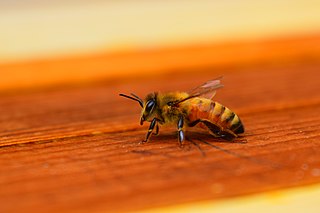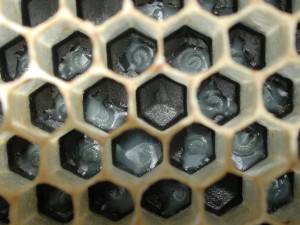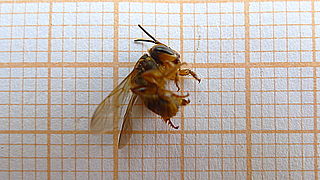The honey bee life cycle, here referring exclusively to the domesticated Western honey bee, depends greatly on their social structure.
Contents

The honey bee life cycle, here referring exclusively to the domesticated Western honey bee, depends greatly on their social structure.

Unlike a bumble bee colony or a paper wasp colony, the life of a honey bee colony is perennial. The three types of honey bees in a hive are: queens (egg-producers), workers (non-reproducing females), and drones (males whose main duty is to find and mate with a queen). Unlike the worker bees, drones do not sting. Honey bee larvae hatch from eggs in three to four days. They are then fed by worker bees and develop through several stages in hexagonal cells made of beeswax. Cells are capped by worker bees when the larva pupates. Queens and drones are larger than workers, so require larger cells to develop. A colony may typically consist of tens of thousands of individuals.
While some colonies live in hives provided by humans, so-called "wild" colonies (although all honey bees remain wild, even when cultivated and managed by humans) typically prefer a nest site that is clean, dry, protected from the weather, about 20 litres (4.4 imp gal; 5.3 US gal) in volume with a 4–6 cm2 (0.62–0.93 sq in) entrance about 3 m (9.8 ft) above the ground, and preferably facing south or south-east (in the Northern Hemisphere) or north or north-east (in the Southern Hemisphere).

Development from egg to emerging bee varies among queens, workers, and drones. Queens emerge from their cells in 15–16 days, workers in 21 days, and drones in 24 days. Only one queen is usually present in a hive. New virgin queens develop in enlarged cells through differential feeding of royal jelly by workers. When the existing queen ages or dies or the colony becomes very large, a new queen is raised by the worker bees. When the hive is too large, the old queen will take half the colony with her in a swarm. This occurs a few days prior to the new queen emerging. If several queens emerge they will begin piping (a high buzzing noise) signaling their location for the other virgin queens to come fight. Once one has eliminated the others, she will go around the hive chewing the sides of any other queen cells and stinging and killing the pupae. The queen takes one or several nuptial flights to mate with drones from other colonies, which die after mating. After mating, the queen begins laying eggs. A fertile queen is able to lay fertilized or unfertilized eggs. Each unfertilized egg contains a unique combination of 50% of the queen's genes [1] and develops into a (haploid) drone. The fertilized eggs develop into either (diploid) workers or queens (if fed exclusively royal jelly).
Every honey bee (Apis mellifera) in a hive exists to perform specific duties determined by their sex and age. Like every member of its colony, the nurse honey bee plays a vital role in the survival of its hive. Nurse bees are charged with the care and feeding of the queen and the next generation.
The average lifespan of a queen is three to four years; drones usually die upon mating or are expelled from the hive before the winter; and workers may live for a few weeks in the summer and several months in areas with an extended winter.
| Type | Egg | Larva | Cell capped | Pupa | Average developmental period (days until emergence) | Start of fertility | Body length | Weight on emerging |
|---|---|---|---|---|---|---|---|---|
| Queen | up to day 3 | up to day 8½ | day 7½ | day 8 until emergence | 16 days | day 23 and up | 18–22 mm (0.71–0.87 in) | nearly 200 mg (3.1 gr) |
| Worker | up to day 3 | up to day 9 | day 9 | day 10 until emergence (day 11 or 12 last moult) | 21 days (range: 18–22 days) | N/A | 12–15 mm (0.47–0.59 in) | nearly 100 mg (1.5 gr) |
| Drone | up to day 3 | up to day 9½ | day 10 | day 10 until emergence | 24 days | about 38 days | 15–17 mm (0.59–0.67 in) | nearly 200 mg (3.1 gr) |
The weight progression of the worker egg, larva: [2]

| Days | Developmental state | Weight | Length | Food source |
|---|---|---|---|---|
| 1 | egg | 0.132 mg (0.00204 gr) | 1.2 mm (0.047 in) | yolk |
| 2 | egg | not listed | yolk | |
| 3 | egg | 0.09 mg (0.0014 gr) | yolk | |
| 4 | larva | not listed | royal jelly | |
| 5 | larva | 3.4 mg (0.052 gr) | royal jelly | |
| 6 | larva | 33.3 mg (0.514 gr) | royal jelly/honey and pollen (bee bread) | |
| 7 | larva | 100.1 mg (1.545 gr) | honey and pollen (bee bread) | |
| 8 | larva | 134.5 mg (2.076 gr) | honey and pollen (bee bread) | |
| 9 | larva | 155.2 mg (2.395 gr) | honey and pollen (bee bread) | |

A honey bee is a eusocial flying insect within the genus Apis of the bee clade, all native to mainland Afro-Eurasia. After bees spread naturally throughout Africa and Eurasia, humans became responsible for the current cosmopolitan distribution of honey bees, introducing multiple subspecies into South America, North America, and Australia.

Yellowjacket or yellow jacket is the common name in North America for predatory social wasps of the genera Vespula and Dolichovespula. Members of these genera are known simply as "wasps" in other English-speaking countries. Most of these are black and yellow like the eastern yellowjacket and the aerial yellowjacket ; some are black and white like the bald-faced hornet. Some have an abdomen with a red background color instead of black. They can be identified by their distinctive markings, their occurrence only in colonies, and a characteristic, rapid, side-to-side flight pattern prior to landing. All females are capable of stinging. Yellowjackets are important predators of pest insects.
Beekeeping is the maintenance of bee colonies, commonly in artificial beehives. Honey bees in the genus Apis are the most commonly kept species but other honey producing bees such as Melipona stingless bees are also kept. Beekeepers keep bees to collect honey and other products of the hive: beeswax, propolis, bee pollen, and royal jelly. Other sources of beekeeping income include pollination of crops, raising queens, and production of package bees for sale. Bee hives are kept in an apiary or "bee yard".

In beekeeping, bee brood or brood refers to the eggs, larvae and pupae of honeybees. The brood of Western honey bees develops within a bee hive. In man-made, removable frame hives, such as Langstroth hives, each frame which is mainly occupied by brood is called a brood frame. Brood frames usually have some pollen and nectar or honey in the upper corners of the frame. The rest of the brood frame cells may be empty or occupied by brood in various developmental stages. During the brood raising season, the bees may reuse the cells from which brood has emerged for additional brood or convert it to honey or pollen storage. Bees show remarkable flexibility in adapting cells to a use best suited for the hive's survival.

A queen bee is typically an adult, mated female (gyne) that lives in a colony or hive of honey bees. With fully developed reproductive organs, the queen is usually the mother of most, if not all, of the bees in the beehive. Queens are developed from larvae selected by worker bees and specially fed in order to become sexually mature. There is normally only one adult, mated queen in a hive, in which case the bees will usually follow and fiercely protect her.

A worker bee is any female bee that lacks the reproductive capacity of the colony's queen bee and carries out the majority of tasks needed for the functioning of the hive. While worker bees are present in all eusocial bee species, the term is rarely used for bees other than honey bees, particularly the European honey bee. Worker bees of this variety are responsible for approximately 80% of the world's crop pollination services.

A drone is a male bee. Unlike the female worker bee, a drone has no stinger. He does not gather nectar or pollen and cannot feed without assistance from worker bees. His only role is to mate with a maiden queen in nuptial flight.
Hive management in beekeeping refers to intervention techniques that a beekeeper may perform to ensure hive survival and to maximize hive production. Hive management techniques vary widely depending on the objectives.

A nuc, or nucleus colony, is a small honey bee colony created from larger colonies, packages, or captured swarms. A nuc hive is centered on a queen bee, the nucleus of the honey bee colony.
This page is a glossary of beekeeping.

The dwarf honey bee, Apis florea, is one of two species of small, wild honey bees of southern and southeastern Asia. It has a much wider distribution than its sister species, Apis andreniformis. First identified in the late 18th century, Apis florea is unique for its morphology, foraging behavior and defensive mechanisms like making a piping noise. Apis florea have open nests and small colonies, which makes them more susceptible to predation than cavity nesters with large numbers of defensive workers. These honey bees are important pollinators and therefore commodified in countries like Cambodia.

Haplodiploidy is a sex-determination system in which males develop from unfertilized eggs and are haploid, and females develop from fertilized eggs and are diploid. Haplodiploidy is sometimes called arrhenotoky.

Apis andreniformis, or the black dwarf honey bee, is a relatively rare species of honey bee whose native habitat is the tropical and subtropical regions of Southeast Asia.

Apis nigrocincta is a species of honey bee that inhabits the Philippine island of Mindanao as well as the Indonesian islands of Sangihe and Sulawesi. The species is known to have queens with the highest mating frequencies of any species of the tribe Apini.

Bombus ternarius, commonly known as the orange-belted bumblebee or tricolored bumblebee, is a yellow, orange and black bumblebee. It is a ground-nesting social insect whose colony cycle lasts only one season, common throughout the northeastern United States and much of Canada. The orange-belted bumblebee forages on Rubus, goldenrods, Vaccinium, and milkweeds found throughout the colony's range. Like many other members of the genus, Bombus ternarius exhibits complex social structure with a reproductive queen caste and a multitude of sister workers with labor such as foraging, nursing, and nest maintenance divided among the subordinates.

Nuptial flight is an important phase in the reproduction of most ant, termite, and some bee species. It is also observed in some fly species, such as Rhamphomyia longicauda.

The western honey bee or European honey bee is the most common of the 7–12 species of honey bees worldwide. The genus name Apis is Latin for 'bee', and mellifera is the Latin for 'honey-bearing' or 'honey-carrying', referring to the species' production of honey.

Apis cerana, the eastern honey bee, Asiatic honey bee or Asian honey bee, is a species of honey bee native to South, Southeast and East Asia. This species is the sister species of Apis koschevnikovi and both are in the same subgenus as the western (European) honey bee, Apis mellifera. A. cerana is known to live sympatrically along with Apis koschevnikovi within the same geographic location. Apis cerana colonies are known for building nests consisting of multiple combs in cavities containing a small entrance, presumably for defense against invasion by individuals of another nest. The diet of this honey bee species consists mostly of pollen and nectar, or honey. Moreover, Apis cerana is known for its highly social behavior, reflective of its classification as a type of honey bee.

Bombus fervidus, the golden northern bumble bee or yellow bumblebee, is a species of bumblebee native to North America. It has a yellow-colored abdomen and thorax. Its range includes the North American continent, excluding much of the southern United States, Alaska, and the northern parts of Canada. It is common in cities and farmland, with populations concentrated in the Northeastern part of the United States. It is similar in color and range to its sibling species, Bombus californicus, though sometimes also confused with the American bumblebee or black and gold bumblebee. It has complex behavioral traits, which includes a coordinated nest defense to ward off predators. B. fervidus is an important pollinator, so recent population decline is a particular concern.

Scaptotrigona postica is a species of stingless bee that lives mainly in Brazil. It is a eusocial bee in the tribe Meliponini. S. postica is one of 25 species in the genus Scaptotrigona and is a critical pollinator of the tropical rain forests of Brazil. They construct their nests in hollowed sections of tree trunks, allowing for effective guarding at the nest entrance. This species shows colony structure similar to most members of the Meliponini tribe with three roles within the colony: queen, worker, and male. S. postica individuals have different forms of communication from cuticular hydrocarbons to pheromones and scent trails. Communication is especially useful during worker foraging for nectar and pollen through the Brazilian tropical rain forests. S. postica is a very important pollinator of the Brazilian tropical rain forests and is widely appreciated for its honey. Stingless bees account for approximately 30% of all pollination of the Brazilian Caatinga and Pantanal ecosystems and up to 90% of the pollination for many species of the Brazilian Atlantic Forest and the Amazon.